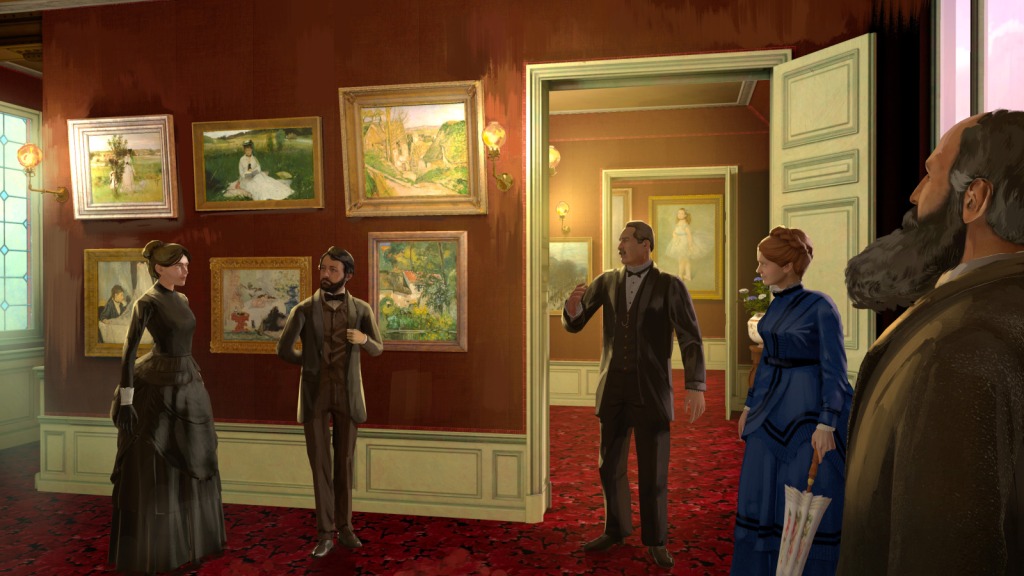Paris, France
€16 (€32 with main entry)
Excurio, GEDEON Experiences, Musée d’Orsay
1 hour
Tonight with the Impressionists is an virtual reality experience where you visit the first exhibition by Impressionist artists in Paris, 1874. You’re guided through the paintings of Monet, Renoir, Morisot, Cézanne, Pissarro, and Degas, with detours to the traditionalist Salon and the moments when key Impressionist paintings were made.
Unlike VR games where you sit or stand at home, visitors literally walk around a large room filled with dozens of other people, often accidentally colliding with them. This alone makes it the worst VR experience I’ve ever been subjected to.
Tonight with the Impressionists is staged at the Musée d’Orsay alongside a major “normal” exhibition, Paris 1874: Inventing Impressionism, featuring 130 impressionist works. There was no recommended order in which to see view the exhibitions, so we headed to the VR experience first.
Even though we arrived very early, there was already a short queue because attendants were carefully helping each visitor don their VR headset, one by one. Since the headsets were standalone with no controllers and no backpack computer (unlike The Void), this didn’t take too long, but the overall throughput was little more than a visitor per minute. We were able to create a “group” so we could see each other in the VR environment, but that was the extent of any multiplayer interaction.
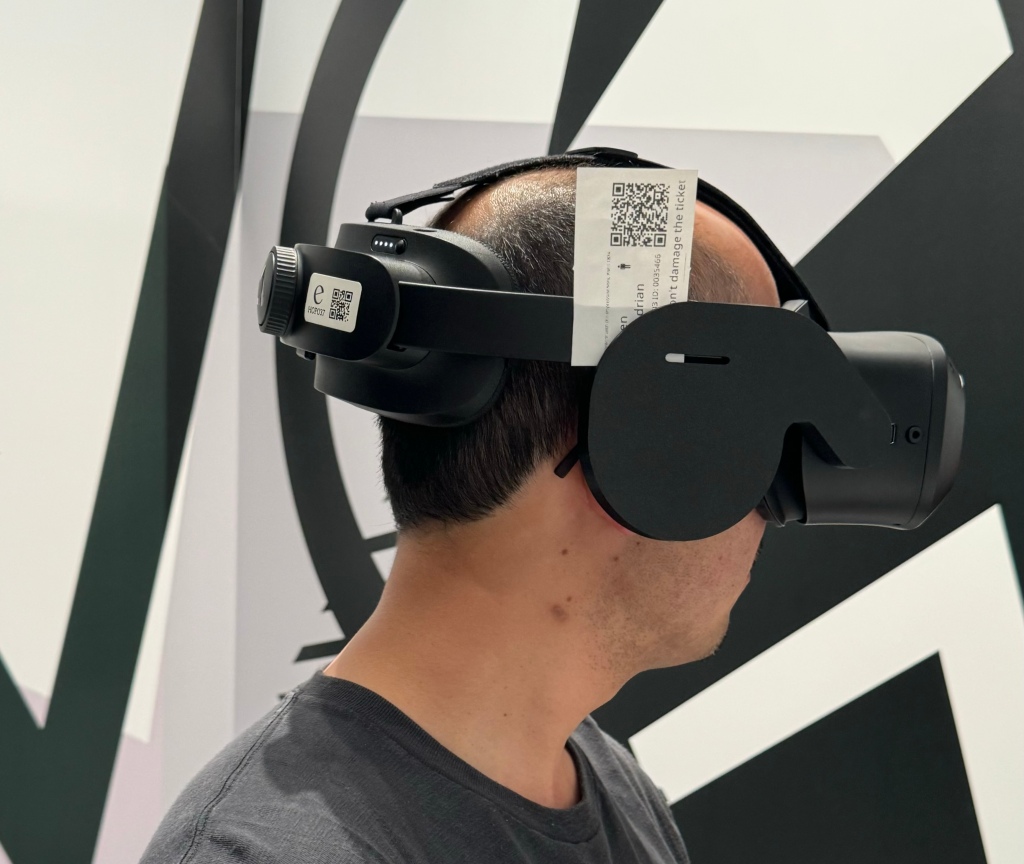
Once my headset was on, I entered a tutorial set in a dark cave-like environment. Glowing lines on the floor and in space indicated the areas where I could safely walk, while also outlining the location of real world obstacles. Paths led toward blue squares, around two metres wide, representing where I was supposed to stand. In cases where I had to walk further – where, essentially, I had been left behind by the on-rails VR experience – the cave environment would dissolve into a Tron-like wireframe world with a monolith showing my destination.
This was A Lot, even for someone who’s done plenty of VR. It’s not that these instructions are conceptually hard to understand, but rather that we still don’t have a standard user interface for VR experiences. What’s more, shifting from the context of a real world museum to a virtual reality cave/exhibition is even more of a shock than, say, being pulled off the street and directly into a movie theatre where a film begins playing instantly.
Anyway, I emerged from the tutorial into the streets of 19th century Paris. The buildings were detailed, well-lit, and rendered smoothly by the HTC Vive Focus 3 headset. There were no frame rate drops or screen door effects, and overall it was one of the best looking VR experiences I’ve seen.
A virtual Parisian strode over and said she’d help us check out the Impressionists’ exhibition: no need (or ability) to say or do anything other than follow her. She probably said something about how the exhibition’s artists set it up in opposition to the official Salon from which they’d been rejected, but I remember nothing of this because all of my attention was dedicated to keeping up.
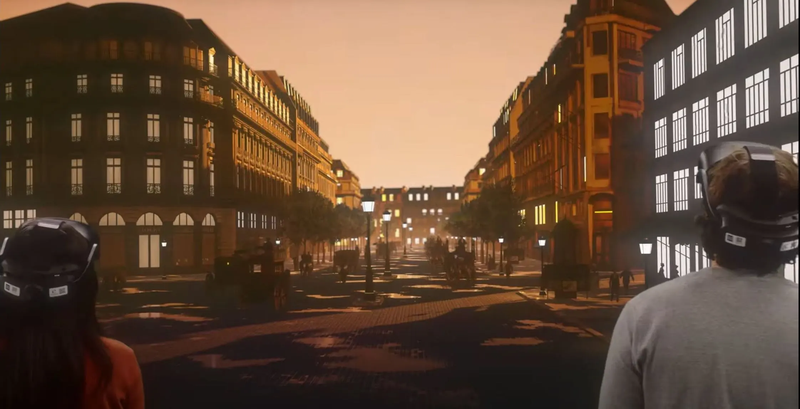
I am, I believe, an experienced navigator in VR. I’m comfortable with all the ways of movement, whether that’s teleportation or smooth stick-driven locomotion or walking around in impossible spaces or via redirected walking. But I was confounded here, for two reasons.
Firstly, Tonight with the Impressionists commits the cardinal sin of making you walk into spaces that don’t exist in physical reality. This happens right at the start, when you have to step off a pavement and into the street. It looks like a shallow drop of only four inches, but it might as well have been a chasm as far as my body was concerned, because I knew that the step couldn’t possibly exist in the real world – even if their VR location tracking was good enough to display it at the requisite accuracy to prevent me from stumbling, it didn’t make any sense to have a step present in such a large space.
Rationally, I knew there was no step, but everything in my visual field was telling me I wasn’t. Obviously I (literally) got over it, but I was very unhappy, and I continued to be unhappy each time it happened, like when I walked up and down inclines that, again, didn’t exist in reality. Instead, I would walk forward and the virtual environment would automatically lift me up or down. Not good!
Only slightly less disturbing were the many virtual walls and armchairs you desperately wanted to lean against or sit down on to rest your legs but again, of course, did not exist. Curtis Hickman, co-founder of The Void, wrote an entire book on why you shouldn’t make these mistakes, Hyper-Reality: The Art of Designing Impossible Experiences. It’s a little tiresome, but I do have to hand it to him in this case.
These are merely conventional errors compared with the true horror that lies at the heart of Tonight with the Impressionists, however. Going in, I knew we’d be walking in the same room as other visitors, but I thought we’d be automatically routed around them, hence the paths and blue spaces and monoliths.
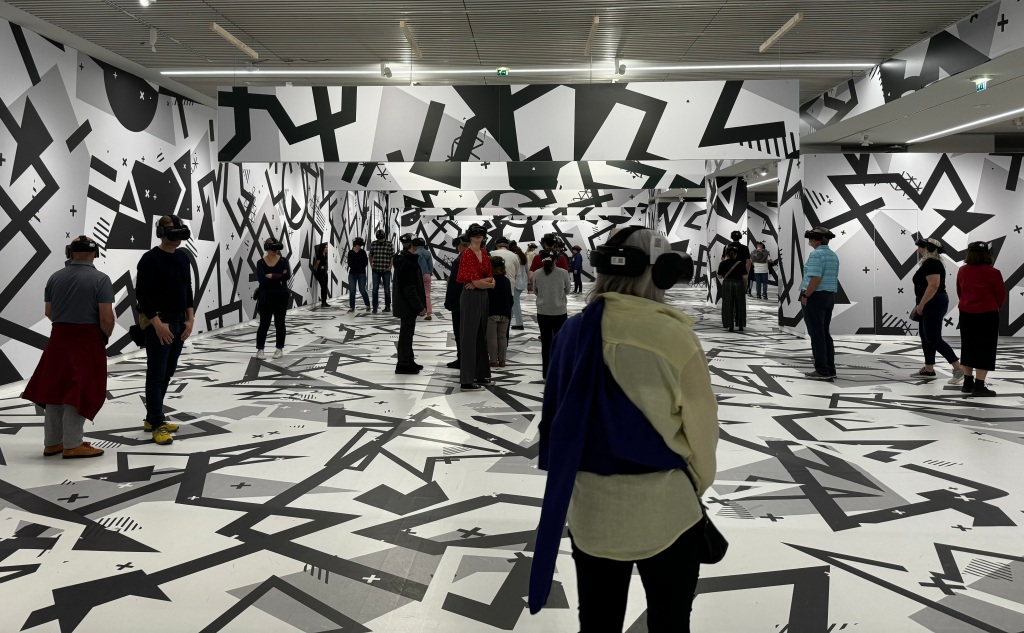
How naive I was! I was constantly distracted by the presence of other visitors in the VR environment, rendered as jerky, ghostly outlines. Visitors became visible from a few metres away, meaning I wasn’t seeing people on the other side of the room, but people standing right next to me – often less than a meter away, often in the way of paintings I was trying to look at. After two people bumped into me, lost in their own exhibitions, I walked even slower, keeping my distance from others as much as possible. Our virtual guide would stride ahead, oblivious of my trials, and I’d be banished to the world of Tron. It got to the point that I’d deliberately walk through walls in order to keep up.
The combined effect of Tonight with the Impressionist’s spatial fuckery and disastrous multi-person routing was not merely irritating, like poor quality graphics, or unpleasant, like a spot of motion sickness. It was unsafe and stressful.
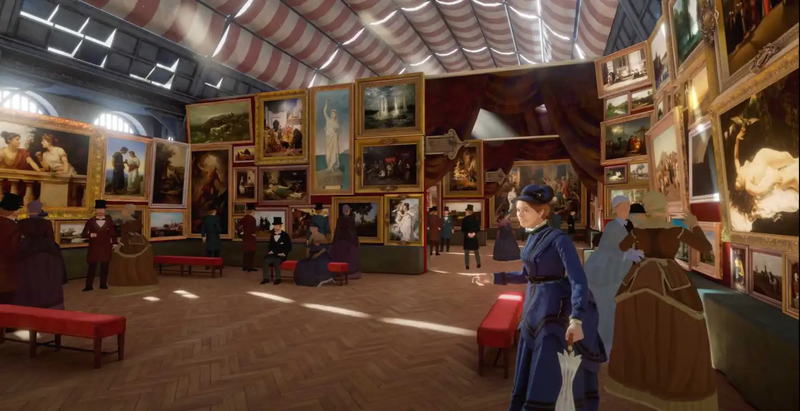
Other than that, how was it? I enjoyed seeing how compact and modest the Impressionists’ exhibition was, and how artists like Monet and Degas would’ve been hanging around the rooms and chatting with visitors, even if their non-stop banter quickly became tiresome. A diversion to the exclusive, monumentally-sized Salon was a nice point of comparison, too.
You will note that I have barely talked about the paintings. While the HTC Vive Focus 3 has an impressive 5K display, this remains inadequate for appreciating the details of a painting viewed at a normal distance. The experience ameliorates this for a few paintings by transporting you to a dark space where a blown-up version floats above. This space comes with visual aids, so Edgar Degas’ La Repasseuse (The Laundress) has silhouettes of people ironing robotically to illustrate Degas’ desire to depict repetitive housework non-romantically.
It’s not bad, and the narration is decent; we hear how Berthe Morisot’s Le Berceau (The Cradle) highlights the mother’s fingers as if wanting to hide her baby with the veil. I would’ve liked to have seen Tonight with the Impressionists use its entire runtime with a similarly abstract, blown-up tour of Impressionist works, but instead we’re back to an experience that’s more interested in the world surrounding the paintings rather than the paintings themselves.
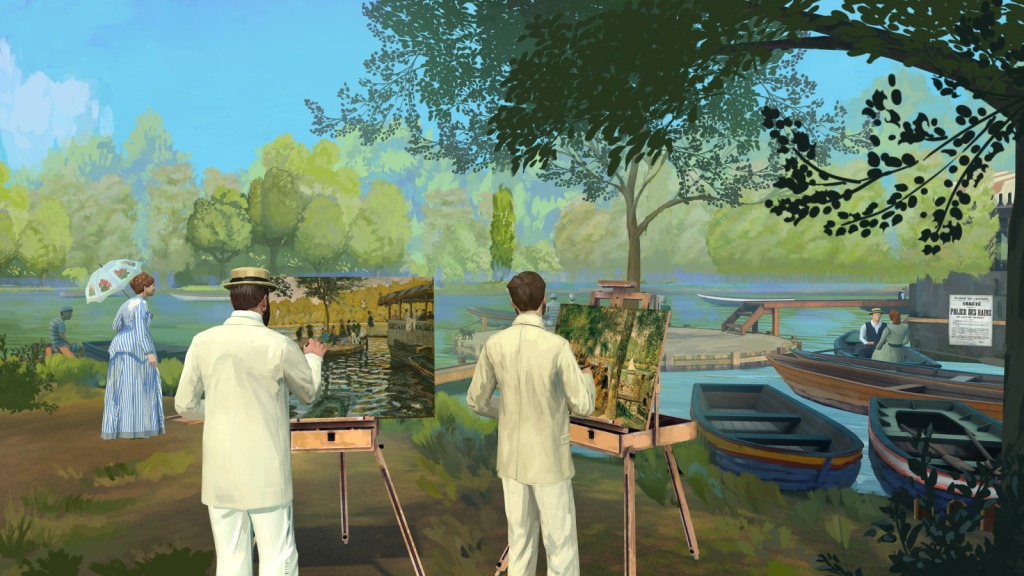
There are moments where this works, albeit fitfully. We join Auguste Renoir and Claude Monet painting side by side at La Grenouillère (The Frog Pond), and it is indeed cool to see the “actual” pond, even if I did have to float up and down a bridge to get there. But when we see Claude Monet painting Impression, soleil levant (Impression, Sunrise), I was distracted by how the Le Havre sunset is literally the same as the artwork. Would it be better to have shown a more photorealistic sunset, or is it more thought-provoking to imagine this is what he “saw”? At least this is a more interesting question to chew on than the endless technical issues.
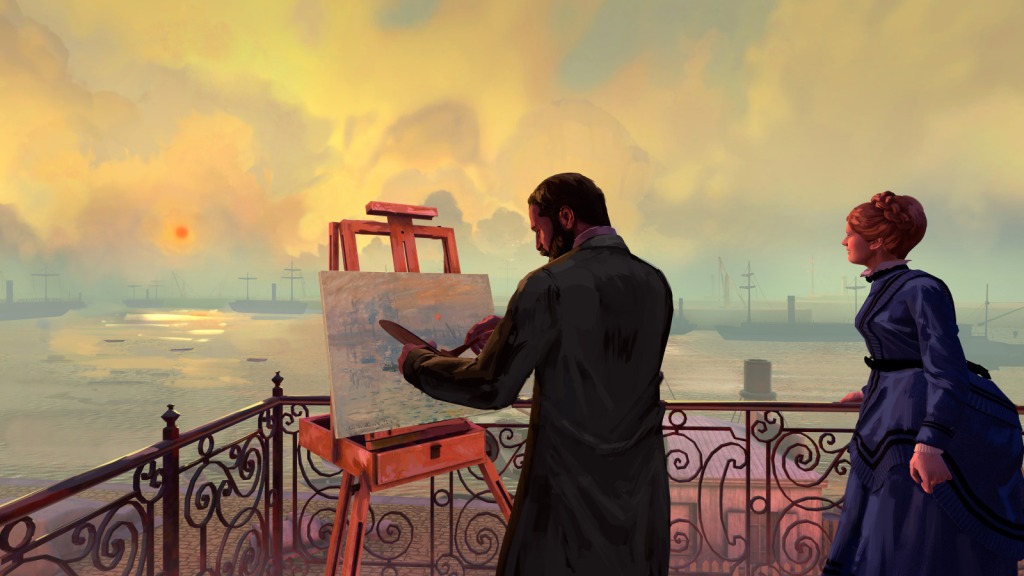
Why is Tonight with the Impressionists so bad? I think it’s because its makers believe that ambulation heightens immersion beyond other forms of VR movement, and immersion enhances the intensity of an experience. That’s why they’re so insistent that visitors physically walk everywhere, even when it feels completely unnecessary. This is not a foolish notion: there is a lot of literature about how immersion relies on imaginative or physical embodiment in a world, so if it worked, visitors might genuinely leave the experience with a stronger memory and appreciation of the Impressionists’ era.
Of course, it didn’t work. Some technologists would have you believe that the wide span between “absolute disaster” and “total success” can only be crossed by trying and failing with experiences like Tonight with the Impressionists, thus excusing it as a necessary, noble casualty on the march to perfect immersion, but they are wrong.
It should’ve been painfully clear at the prototype stage that this was a non-starter. The first time a VR character walked through me, I practically fell over because I was spending so much time trying to avoid the visitor ghosts who couldn’t walk through me. Ghosts who, I might add, cannot be seen through virtual walls, meaning that when I was in a narrow corridor, visitors would suddenly appear right in front of me and I’d have to jump back to avoid them.
I assume (or hope) the experience is designed such that visitors’ paths are spaced apart dynamically to keep them well away from each other. Unfortunately, in the real world, people don’t always stand where they’re meant to, and until Disney’s new HoloTile floor becomes widespread, there’s no way of physically moving them other than manhandling them, which is obviously a tricky proposition in VR. As a result, the experience frequently draws paths leading you directly into groups of visitors.
The final proof of Tonight with the Impressionists’ overreach comes at the end, when you enjoy fireworks from a Parisian rooftop. To get up there, you walk along narrow scaffolding – so narrow that I had to walk through the air instead to avoid errant ghosts.
I had a peculiar sensation of “reality sickness” after Tonight with the Impressionists, not like mal de debarquement when you return to land after a long journey at sea. I didn’t experience a moment of nausea in VR itself, but once I removed the headset I found myself misjudging how close things were, perhaps a result of the lens and 3D rendering used in the experience. This is just about OK when you’re at home, less so when you’re thrust into the crowds of streaming through the Musée d’Orsay.
Fortunately, I wasn’t in the mood to be charging about. Anyone over the age of 40 will know the exquisite suffering that comes from walking slowly and deliberately for the best part of an hour. It’s very different from more energetic VR games where you have more freedom of movement and fewer people to bump into, and where you can take a break and sit down whenever you like.
Obviously, it would’ve been much better if it were shorter. But if it was shorter, how would they justify charging €16? But if they charged less, how could they afford all the fixed costs? But if, but if, but if.
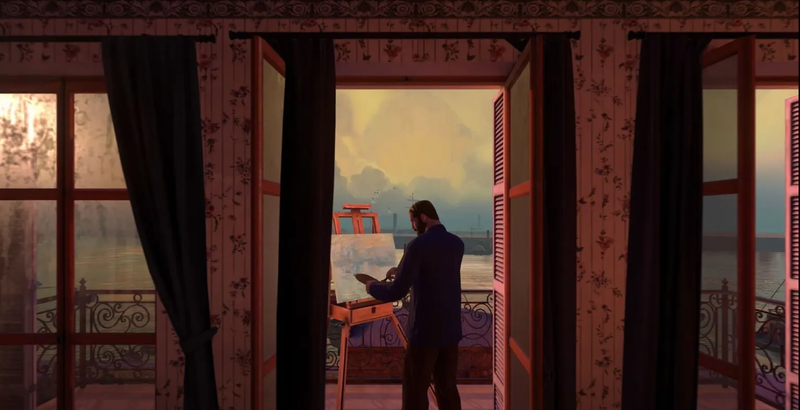
In 2015, I wore the Oculus Rift Development Kit 2 VR headset of the first time and decided VR would change everything. A year later, I visited a packed exhibition at the British Museum – almost as packed as the proper Impressionists exhibition at the Musée d’Orsay – and wrote VR Will Break Museums, where I argued museums’ physical limitations and hidebound thinking would be annihilated by the white heat of VR museums.
I was wrong – at least when it came to the timing, and perhaps much more. Technological hurdles are not easily overcome, and even when you have the technology right, it can take decades for the art and software and audiences to catch up. Tonight with the Impressionists is the best riposte to my wild dreams.
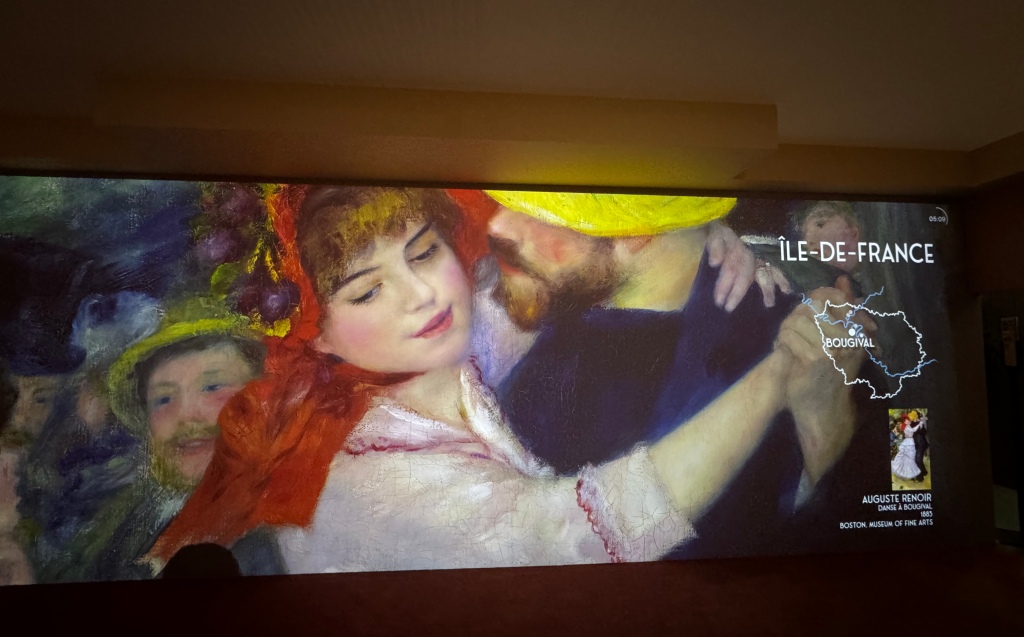
When it comes to appreciating art, we have a long way to go until the technical limitations of virtual reality are addressed. In the meantime, there are plenty of hybrid solutions. I’ve long scoffed at immersive experiences that “only” project art onto walls, most infamously Immersive Van Gogh, but after seeing Impressionist art projected at the end of the exhibition, I have to admit it looks a damn sight better than anything in VR, and much more comfortable to look at, too.
Even more exciting was Cosquer Méditerranée in Marseille. It’s a brand new museum whose centrepiece is an exceptionally long 35 minute dark ride through an incredibly detailed recreation of the palaeolithic cave art of the Cosquer Cave. The ride uses the latest theme park technology to provide one of the most usefully immersive experiences I’ve ever had. It’s not reality or virtual reality – it’s something in between.
Bonus Baudrillard
While reading Marie-Laure Ryan’s Narrative as Virtual Reality 2, I came across this perfect quote from Jean Baudrillard in The Virtual Illusion: Or the Automatic Writing of the World (1995)
…Some new museums, in a sort of Disneyland processing, try to bring people not in front of the painting, which is not interactive enough, and even suspect as pure spectacular consumption, but into the painting. By insinuating them audio-visually into the virtual reality of the the Dejeuner sur l’herbe, people will enjoy it in real time, feeling and tasting the whole Impressionist context, and eventually interacting with the picture. Well, the masses usually prefer the passive roles, and keep away from representation. This must change, and they must be invested as interactive partners. No question of free speaking or free acting – just break their resistance and destroy their immunities.
Baudrillard’s argument is that the indifference and silence of modern citizens is a threat to the political and cultural class, who demand engagement and interaction to legitimise their existence. That interaction can only be on their terms, however, hence the pseudo-interactivity he imagines museumgoers will be offered in the future. Sadly, Manet’s Le Déjeuner sur l’herbe wasn’t in Tonight with the Impressionists – it was a little early for that – but my interacting with the pictures in La Grenouillère wasn’t far off.
It’s always hard to know how seriously to take Baudrillard’s later essays given how much he likes to torment readers with his constantly shifting positions. While I think there’s a lot to the argument that immersive experiences simply provide the illusion of agency and could be seen as merely capitalist pacification, I also think we can make VR art experiences that are truly freeing. Unfortunately, Tonight with the Impressionists seems determined to prove Baudrillard right.
